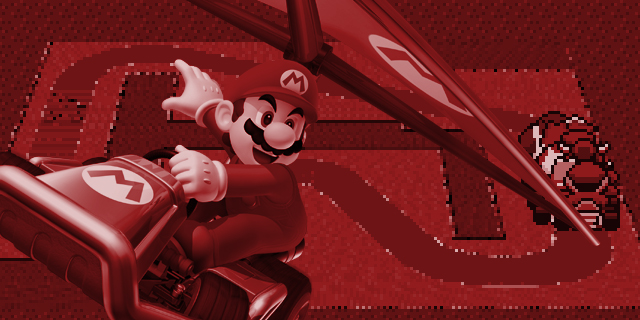
In From Pixels to Polygons, we examine classic game franchises that have survived the long transition from the 8- or 16-bit era to the current console generation.
Mario Kart brought characters from the Mario franchise and put them together in a rather casual setting, where Bowser wasn’t the villain and Peach didn’t have to be saved. It was just good old-fashioned racing. Since its start in 1992, the series has evolved quite a bit.
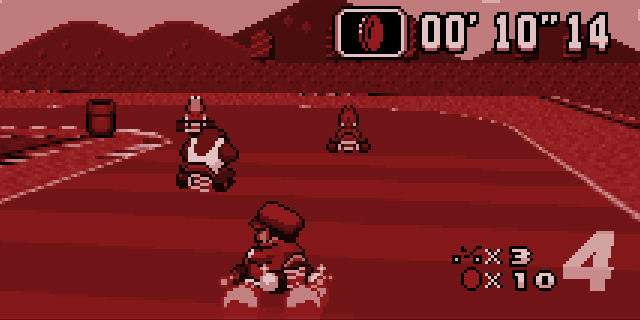
Where the plumber meets the road

Super Mario Kart came into being as a project with the end goal of having a two-player game with simultaneous play. What better way to do that than a split-screen racing game? It used Mode 7 tech, featured a roster full of classic characters and had several different modes of play (including the fan favorite, battle mode). Crucial power-ups came in the form of various silly items from throughout Mario history, and AI characters even had their own unique items to use against the player.
SMK is credited as being the pioneer game of a new genre, and the series has continued to evolve as well as inspire other franchise racers to come onto the scene. Nowadays, the kart racer is commonly seen as a joke, but whenever a new Mario Kart appears, every cash-grab imitator is promptly forgotten.
Super Circuit, the follow-up to Mario Kart 64 and the first handheld entry, was developed by Intelligent Systems rather than EAD. It not only had brand-new tracks, but also many from the previous two games, and hewed closer to the original’s formula than any game since. Perhaps its most notable feature allows players to play a limited version of the game when linking up GBAs with only one copy of the game. – Lucas White
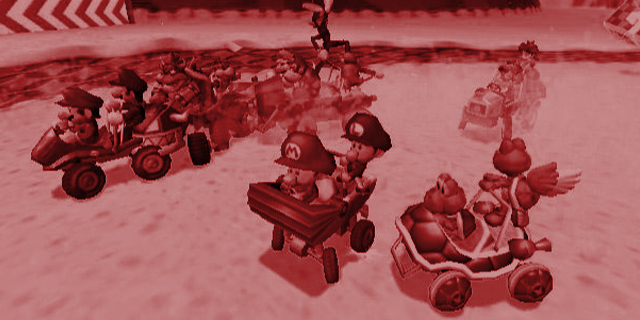
Kings of the couch

The popularity of Super Mario Kart meant that a N64 sequel was inevitable, and it didn’t disappoint. Two-player Grand Prix, four-player versus play and the almighty battle mode meant a plethora of multiplayer options. The racing was slower compared to its successor, but the world breathed. Racing in glorious 3D (albeit with 2D sprites) was phenomenally fun. Track design on some levels was flawless, and dynamic environmental dangers were used more frequently. The visuals haven’t aged well, but Mario Kart 64 was a true pioneer. Other additions followed the switch from 2D to 3D: the introduction of “power sliding” meant for a deeper racing experience, and the bane of all in the lead, the infamous blue shell, made its debut.
Mario Kart: Double Dash!! may be the most controversial game of the series. Many were disappointed that after a seven year hiatus, Double Dash!! didn’t feel revolutionary, but others were thrilled. You now controlled two racers: one would pilot the kart, and the other would handle items. Strategy now came into play. Which character’s special ability will help you the most? Is there a specific combination effective for a particular map? The possibilities for multiplayer insanity were limitless, thanks to the LAN capabilities using the GameCube’s broadband adapter. Track design wasn’t as tight as in previous incarnations, but many will point to Double Dash!! as their favorite in the entire series, and it’s easy to see why. – Henry Skey
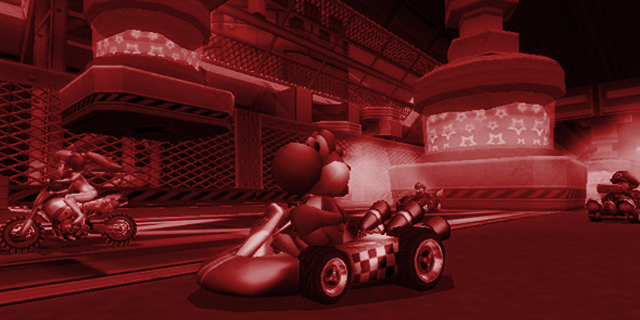
Getting behind the wheel

The arrival of Mario Kart DS can arguably be considered the beginning of the modern era of the series. The online features of the DS allowed racers to take their skills to the world, finally able to compete with their friends even when they weren’t in the same room. A few new racing techniques were debuted here as well, like sliding and drafting, though players eventually learned that they could abuse sliding for a speed advantage. The inclusion of 16 classic courses alongside the sixteen new ones also gave players more variety while indulging nostalgia.
Mario Kart Wii managed to fulfill expectations, thanks to the inclusion of a steering wheel accessory and motion controls, though the changes to the battle modes were not well-received. The reason? All games took the form of two-team matches, without solo options. The motion controls were accurate, though sometimes too sensitive, and traditional controls continued to be the most reliable for making sure you beat your friends. Mario Kart Wii also changed the mechanics of racing more than any previous entry had, adding motorcycles and multiple karts to the roster for each character and expanding the format from eight racers to twelve. Both changes improved the race dynamic and, with some adjustments to how sliding worked and new aerial tricks, made racing more complex and even slightly strategic.
All these changes made Mario Kart Wii the highest-selling entry in the series, and set a high mark for future games to meet. – Shawn Vermette
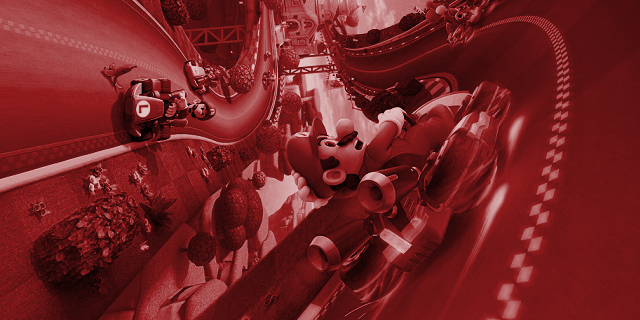
Where we’re going, we don’t need roads
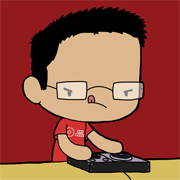
By the time of the 3DS’ release, what could Nintendo possibly do to spice things up for the series? Mario Kart 7 sported a much-needed emphasis on two elements that seemed to be the bane of many Mario Kart players: air and water. Karts now had a retractable hang glider, allowing players to soar through the air, and a propeller, letting them traverse through sections of water. Players were now also able to customize karts with various pieces, and a few new power-ups made races fresh.
Mario Kart 8 is set to release in Spring 2014, and bikes, hang gliding, and underwater driving are set to return. Anti-gravity segments are set to be the entry’s most prominent innovation, allowing players to see the course and race in a completely new perspective. I’m curious about how this feature will play into classic courses, since they seem to be a prominent part of many of the recent games. – Eric Albuen
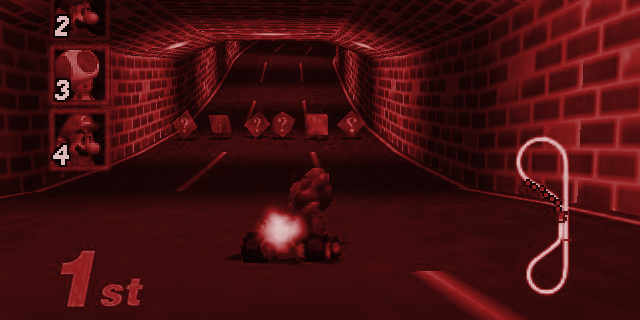
What’s the peak of the Mario Kart series?
 Lucas: My favorite, Double Dash!!, had a few things going for it: the character swapping was cool, and the special items combined with the ability to hold two at once made fighting against the tenacious AI much more doable. The karts were all unique and responsive, and the way drifting worked really clicked with me.
Lucas: My favorite, Double Dash!!, had a few things going for it: the character swapping was cool, and the special items combined with the ability to hold two at once made fighting against the tenacious AI much more doable. The karts were all unique and responsive, and the way drifting worked really clicked with me.
 Shawn: Mario Kart 64 will always hold the crown for me in terms of nostalgia, but the best game in the series, to me, is Mario Kart Wii and it’s not even close. The course and kart selection are top-notch, and twelve racers, drifting and racing on bikes instead of karts put the gameplay above any other entry.
Shawn: Mario Kart 64 will always hold the crown for me in terms of nostalgia, but the best game in the series, to me, is Mario Kart Wii and it’s not even close. The course and kart selection are top-notch, and twelve racers, drifting and racing on bikes instead of karts put the gameplay above any other entry.
 Henry: Super Mario Kart isn’t necessarily the best, but it’s aged remarkably well, and the controls never felt tighter. Playing the original Bowser’s Castle and Rainbow Road is still a treat. It’s simple, addicting and one of the all-time greats.
Henry: Super Mario Kart isn’t necessarily the best, but it’s aged remarkably well, and the controls never felt tighter. Playing the original Bowser’s Castle and Rainbow Road is still a treat. It’s simple, addicting and one of the all-time greats.
 Eric: As much as I love the later entries in the series, I think I’ll always consider Mario Kart 64 to be the peak. While the refined features and online modes of the newest games were nice, there’s always something enjoyable about playing friends in the comfort of your own home.
Eric: As much as I love the later entries in the series, I think I’ll always consider Mario Kart 64 to be the peak. While the refined features and online modes of the newest games were nice, there’s always something enjoyable about playing friends in the comfort of your own home.
In our next installment, we head to Zebes and look at the Metroid franchise. For more, check out the archive.



















